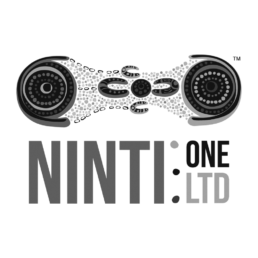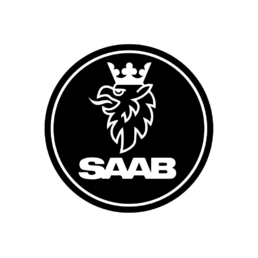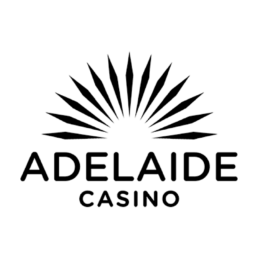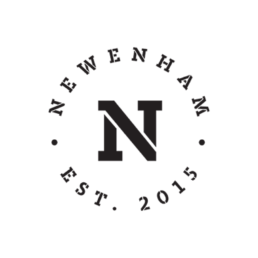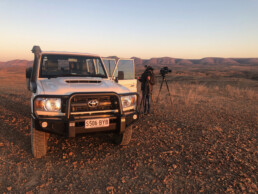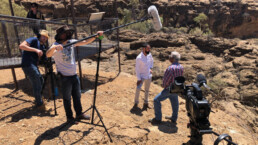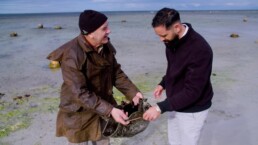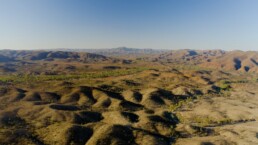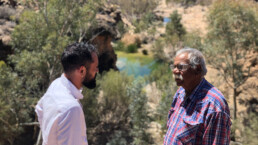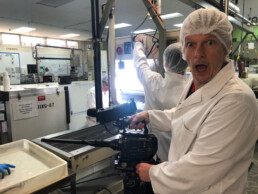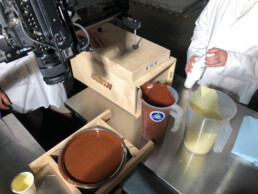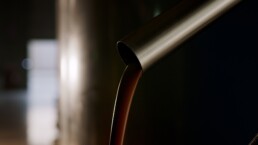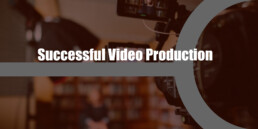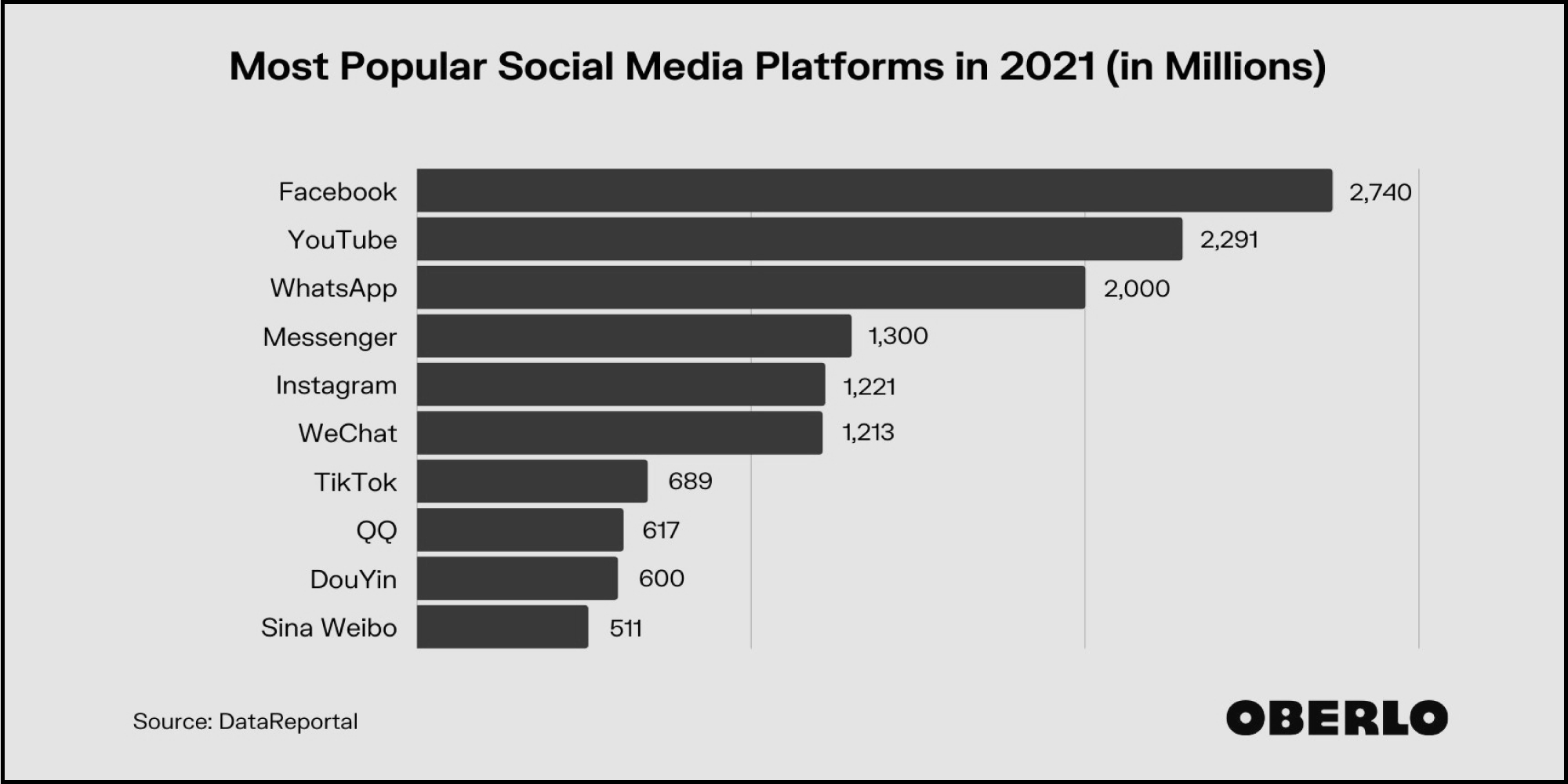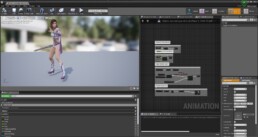Diabetes SA Video Commercial
South Australian advertising and digital agency Bigwig approached redbikini with the idea to film an eyeball up close for a Diabetes SA commercial, in part highlighting the correlation between the disease and its damaging impact on vision.
In theory, the concept seemed simple enough, but the filming process was in fact incredibly complex and technical and required a high-level of expertise and patience to perfect.

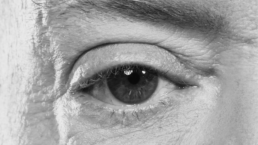

Img. Process Involved Behind The Perfect Shot
Beginning with an extreme close up of the pupil, the camera tracked back over the course of 20 seconds to end with the reveal of a man’s face.
redbikini sourced a specialised macro lens for one of our 4k cameras, which was mounted on a dolly with a wireless follow-focus. This was the only way we could achieve the required shots in both the closeup and wide aspects and still maintain focus.
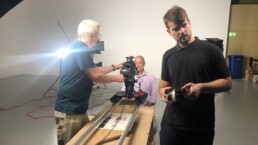
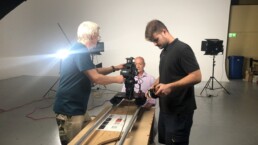
Img. Process Involved Behind The Perfect Shot
Filming took half a day to nail just one perfect shot, but we’re incredibly proud of the end result, which you can check out here.
WHAT OUR CLIENTS SAY
The quality of the work is outstanding. Justin, Danielle and the team’s enthusiasm for what they do is obvious. They continue to raise the bar in finding ways to approach all videos, and dealing with them is a delight.
Defence SA and the South Australian Space Industry Centre have used the services of redbikini for many years and have always appreciate their willingness to push the boundaries and deliver outstanding results. Their attention to detail and library of footage is priceless and the team are always on hand to make last minute changes and work to tight deadlines without compromising quality. The agency will continue to recommend redbikini to stakeholders who are looking for services that they provide specific to defence and space industry as we know they are experts in this area.
Highly recommend Justin and the team for a professional service and high-quality result. From the initial concept meeting through to delivery, the process was seamless and the outcomes have exceeded expectations.
A company that produces brilliant results, no matter what task we have given them. Many have asked who produced our videos due to their premium quality.
We engaged redbikini at Haigh’s Chocolates for the development of a cinema advertisement and series of promotional videos to raise brand awareness and customer engagement across our network of retail stores. We found Justin and his team a pleasure to work with bringing a unique creative approach to meet our brief. They carried out their business with the utmost professionalism and organisation, making everything seem so easy and effortless to get the outcome we were after. They are always a pleasure to work with. We were very happy with the end result and would highly recommend them.
We have been working with redbikini for the past 10 years and are delighted to be able to provide a reference for them. redbikini were engaged to develop a series of TV commercials targeting people working in the livestock industry. These TV commercials required travel across the Australian continent, in regional and remote areas. The conditions were often challenging, particularly when using equipment that is sensitive to dust! We found Justin and his team a pleasure to work with, bringing a unique creative approach to meet our brief. They carried out their business with the utmost professionalism and organisation, making everything seem so easy and effortless to get the outcome we were after. The resulting imagery is highly cinematic, capturing the reality of farm life and contributing to the growth of our brand across Australia. We were very happy with the end result and would highly recommend them.
redbikini act with the highest professionalism making the experience fun and creative. redbikini are knowledgeable, approachable, easy going with a fine eye for detail and a willingness to accept nothing but the best.
The team at redbikini are terrific work with, and highly professional. Bentleys as been delighted with the quality of their work. Their productions have helped us achieve our corporate objectives and get where we want to be.
Water Wisdom | Five Part Series For SA Water
Water Wisdom is a five-part series created by redbikini and broadcast on the ABC, examining how South Australia’s Indigenous communities manage their water resources.
Commissioned by SA Water, redbikini was asked to showcase the various ways aboriginal groups source and manage their fresh water resources across the state in a series of videos designed with the intention of being published through SA Water’s digital channels.
Our recommendation was that rather than create the videos in traditional ‘corporate video’ style, they would work best (and appeal to a broader audience) if they were done in a presenter-led format with a TV ‘science show’ approach – an idea SA Water was very happy to run with.
We engaged well-known and proud Kaurna man Jack Buckskin as host and travelled to various locations across the state, including the far west coast, Adelaide Plains, south east, northern Flinders Ranges and the Coorong and Lower Lakes.
On location we got to shoot the picturesque landscapes and interview local Aboriginal elders and community members to gain insight into their practices.
The more we delved into the subject matter, we quickly realised just how different the environment was in each region, and how each region’s groups varied in their approach to water and water management. This led to a fascinating and hugely successful showcase about the variety of techniques and technology used by Australia’s First Nation people.
Once completed the series was picked up for distribution online on ABC iview, and subsequently broadcast on the ABC Me television channel.
- See what all the excitement is about here: WATER WISDOM SERIES
WHAT OUR CLIENTS SAY
The quality of the work is outstanding. Justin, Danielle and the team’s enthusiasm for what they do is obvious. They continue to raise the bar in finding ways to approach all videos, and dealing with them is a delight.
Defence SA and the South Australian Space Industry Centre have used the services of redbikini for many years and have always appreciate their willingness to push the boundaries and deliver outstanding results. Their attention to detail and library of footage is priceless and the team are always on hand to make last minute changes and work to tight deadlines without compromising quality. The agency will continue to recommend redbikini to stakeholders who are looking for services that they provide specific to defence and space industry as we know they are experts in this area.
Highly recommend Justin and the team for a professional service and high-quality result. From the initial concept meeting through to delivery, the process was seamless and the outcomes have exceeded expectations.
A company that produces brilliant results, no matter what task we have given them. Many have asked who produced our videos due to their premium quality.
We engaged redbikini at Haigh’s Chocolates for the development of a cinema advertisement and series of promotional videos to raise brand awareness and customer engagement across our network of retail stores. We found Justin and his team a pleasure to work with bringing a unique creative approach to meet our brief. They carried out their business with the utmost professionalism and organisation, making everything seem so easy and effortless to get the outcome we were after. They are always a pleasure to work with. We were very happy with the end result and would highly recommend them.
We have been working with redbikini for the past 10 years and are delighted to be able to provide a reference for them. redbikini were engaged to develop a series of TV commercials targeting people working in the livestock industry. These TV commercials required travel across the Australian continent, in regional and remote areas. The conditions were often challenging, particularly when using equipment that is sensitive to dust! We found Justin and his team a pleasure to work with, bringing a unique creative approach to meet our brief. They carried out their business with the utmost professionalism and organisation, making everything seem so easy and effortless to get the outcome we were after. The resulting imagery is highly cinematic, capturing the reality of farm life and contributing to the growth of our brand across Australia. We were very happy with the end result and would highly recommend them.
redbikini act with the highest professionalism making the experience fun and creative. redbikini are knowledgeable, approachable, easy going with a fine eye for detail and a willingness to accept nothing but the best.
The team at redbikini are terrific work with, and highly professional. Bentleys as been delighted with the quality of their work. Their productions have helped us achieve our corporate objectives and get where we want to be.
GET IN TOUCH
A high-quality video for a high-quality brand; Haigh’s Chocolates
Long regarded as one of South Australia’s most treasured and successful brands, Haigh’s Chocolates engaged the services of video production company redbikini to give audiences a behind the scenes look at its processes.
Bean to Bar is a video collaboration between redbikini and Haigh’s, which captures the essence of what makes Haigh’s chocolates so special. The video showcases the steps involved in the art chocolate-making, which includes the revered Adelaide brand sourcing its own cocoa beans from around the world.
Fig. Production Team In Action
redbikini was tasked with finding creative ways to raise the (chocolate) bar when presenting the crafting processes and demonstrating how involved the chocolatiers are from start to finish as Haigh’s prides itself on making its chocolate from scratch to achieve their unique flavour.
The onus was on making the footage, dramatic, cinematic and mouth-watering. Every step of the process was analysed and redbikini developed creative ways to best illustrate the delicious craft. From filming in their pristine factory at Mile End, to recreating the bean roasting process in studio – complete with flame – and working with food stylists, redbikini made sure every shot looked the best it could.
Pushing the boundaries of filming, the team behind redbikini researched the best types of cameras and lenses to use in order to make the end result as cinematic as possible.
During the post-production phase, time was spent to ensure every aspect of the video was complementary, including the music that went with the vision and graphics. The end result, which will be distributed to Haigh’s database and played in stores and online, speaks for itself.
WHAT OUR CLIENTS SAY
The quality of the work is outstanding. Justin, Danielle and the team’s enthusiasm for what they do is obvious. They continue to raise the bar in finding ways to approach all videos, and dealing with them is a delight.
Defence SA and the South Australian Space Industry Centre have used the services of redbikini for many years and have always appreciate their willingness to push the boundaries and deliver outstanding results. Their attention to detail and library of footage is priceless and the team are always on hand to make last minute changes and work to tight deadlines without compromising quality. The agency will continue to recommend redbikini to stakeholders who are looking for services that they provide specific to defence and space industry as we know they are experts in this area.
Highly recommend Justin and the team for a professional service and high-quality result. From the initial concept meeting through to delivery, the process was seamless and the outcomes have exceeded expectations.
A company that produces brilliant results, no matter what task we have given them. Many have asked who produced our videos due to their premium quality.
We engaged redbikini at Haigh’s Chocolates for the development of a cinema advertisement and series of promotional videos to raise brand awareness and customer engagement across our network of retail stores. We found Justin and his team a pleasure to work with bringing a unique creative approach to meet our brief. They carried out their business with the utmost professionalism and organisation, making everything seem so easy and effortless to get the outcome we were after. They are always a pleasure to work with. We were very happy with the end result and would highly recommend them.
We have been working with redbikini for the past 10 years and are delighted to be able to provide a reference for them. redbikini were engaged to develop a series of TV commercials targeting people working in the livestock industry. These TV commercials required travel across the Australian continent, in regional and remote areas. The conditions were often challenging, particularly when using equipment that is sensitive to dust! We found Justin and his team a pleasure to work with, bringing a unique creative approach to meet our brief. They carried out their business with the utmost professionalism and organisation, making everything seem so easy and effortless to get the outcome we were after. The resulting imagery is highly cinematic, capturing the reality of farm life and contributing to the growth of our brand across Australia. We were very happy with the end result and would highly recommend them.
redbikini act with the highest professionalism making the experience fun and creative. redbikini are knowledgeable, approachable, easy going with a fine eye for detail and a willingness to accept nothing but the best.
The team at redbikini are terrific work with, and highly professional. Bentleys as been delighted with the quality of their work. Their productions have helped us achieve our corporate objectives and get where we want to be.
7. Distribution | 7 Essential Steps To Successful Video Production
In this seven-part blog series we’ve detailed the steps required for successful video production and how it works to maximise your marketing opportunities. Having already delved into strategy, scripting, pre-production, production, editing and animation and finishing and delivery, we’ve arrived at the final step – distribution. Essentially, this part is about getting your video in front of the audience you uncovered back in the strategy stage and how to ensure you keep them in order to get a return on the investment put into creating your content.
-
VIDEO KILLED THE RADIO STAR
There’s no denying the power of video content. In this day and age, video has become the favoured way to inform and entertain audiences, trumping the written word and still images. You only need to look at the proliferation of streaming and online platforms such as YouTube and TikTok, which are geared toward content and content delivery, to see the power of video. Everyday people like you and me are dominating the world wide web, with tens of millions, even hundreds of millions of followers and earning a comfortable living all because they found a niche in the market and successfully promote themselves.
Just how powerful is video? Well, all social media platforms have become video content platforms. In fact, three years ago Facebook – once the ruler of social media – announced that it was no longer a social media platform but a video platform.
And although the technological landscape is forever evolving, the one constant is video, and it plays a super important role with consumers and the business community. In some instances, the mere mention of video can increase email rates, meaning if the email subject line contains the word ‘video’ research has shown that people are more inclined to open it because of the promise of easily digested content.
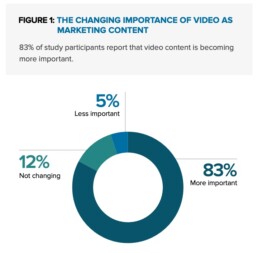
So how do you get your video in front of audiences? Well, for your video content to be truly effective and provide a return on investment, you need not only a good video strategy, but a sound distribution strategy too, so that you meet your marketing goals. You can have the best content in the world, but if you can’t get it out there into the world, what’s the point? It’s a waste of time, money and resources.
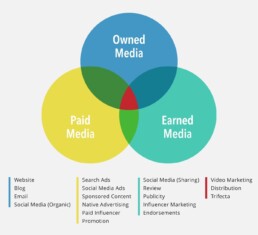
-
START AT THE BEGINNING
First things first, your distribution strategy begins with your viewers. Whether your intended audience is business to business (b2b), business to consumer (b2c) or business to government (b2g), you need to know where to find these viewers – your buyers – and understand what is the best content to put in front of them in each environment. This is something you would have covered in the strategy component of video production.
As an example, it could mean producing various durations of your video content, but even bigger than that, it is about having an understanding of the entire customer journey. This is far more involved and complex than simply finding people, putting a video in front of them and watching the money roll in. No. There are many steps involved, such as attracting your audience’s attention, engaging with them, getting them to take some form of action be it providing an email address when they visit a landing page, and finally continuing to nurture them so they become customers – loyal ones.
Each step of the content distribution process requires a different approach. At the beginning of the journey, your distribution may be far and wide and varied, but you then want to focus it down so you can control the information you obtain, such as email addresses and databases, and then re-market it in order to bring your costs down and make the audience more targeted. It is far more important to have purpose-built content for each stage of the customer’s journey, and it’s important to note that attraction content is different from engagement content and again different from nurturing content. Learn these differences.
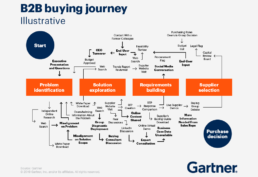
-
THE POWER OF REACH
In 2021 the power and abilities of digital platforms to deliver content to precise audiences is better than ever before. All of the available online tools such as social media, media buying and advertising platforms are incredibly useful to businesses and when combined with an effective distribution and creative strategy can deliver a huge return on investment. That being said, success comes with the proviso that every part of the process is done correctly because even the slightest error can lead to a diminished value.
So, what do you need to do? Take the horse by the reigns, take charge, be proactive and always think one step ahead. In a nutshell – do everything you should be doing. It may sound complex, but the key here is to just do it. If someone is taking the time to visit your website, you need to make sure you re-market to them so they become loyal to you. If you spend all your time creating great content and building your database but then don’t follow up and nurture that audience, then essentially, you’ll fall at the last hurdle and all those previous efforts would have been a waste of time. It’s about making sure every step is working properly and every single cog is turning, and this is where the experts such as the team at redbikini can help.
redbikini, which specialises in marketing strategy, concept development and scripting for video, established a new and exciting arm to their business in 2020 – specialist B2B marketing company, Loop.
Born and bred in South Australia, Loop, which purely targets SMEs offers clients a full range of services, including strategy, content, delivery, measurement and automation in one package. And the best bit is that the cost is almost certainly lower than if you decided to do it yourself.
Here at redbikini we live and breathe all things video production, offering more than 20 years’ on-set experience. We are experts and passionate about what we do. From quick social, to web or online videos, training videos, animated videos, corporate videos, promotional videos, sales videos, product launch videos, event videos, and TV commercials to long form television programs and documentaries. You name it, we do it.
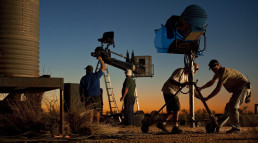
A one-stop-shop, redbikini’s full service offering as a video agency includes pre-production, logistics, location scouting, casting, scheduling and more, and we’re only a quick phone call, or email, away from providing our expert advice and guidance.
Follow our blog to stay up to date with the latest from redbikini.
GET IN TOUCH
6. Finishing and Delivery | 7 Essential Steps To Successful Video Production
Our seven-part blog series detailing the essential steps to help nail your video content marketing is nearing the end.
Having already covered strategy, scripting, pre-production, production day and editing and animation, we’ve arrived at step 6 – finishing and delivery. You’re so close to seeing your masterpiece in all its shining glory!
What exactly happens at this stage?
Well, finishing, as the word suggests, is about completing your video, adding those final touches and the art of finesse. You’re at a significant point in the process – fantastic script, a successful shoot and raw material that’s been edited into a storyteller’s dream. Now it’s time to add the last bit of polish to make your video shine.

First things first, this is still a stage where some technical steps need to be followed before your video masterpiece is complete and ready to be shared with the world.
-
GRADING
Like photoshop but for moving images, grading improves a picture’s overall quality through performing adjustments, such as lighting, on it. The amount of grading required depends on the project, as some will require more than others. Some projects might feature content derived from various sources (such as different businesses) or that were shot at different times or using different cameras, which might mean that features such as skin tone, lighting, and overall film quality seem ‘off’. However, the beauty of the grading process is that it provides editors with an opportunity to make the overall finished product look and feel consistent.
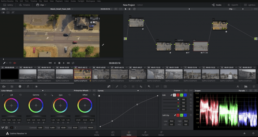
2. SOUND MIX
This is where every single sound element in your project is mixed to maintain its overall prominence without overtaking other audio files used within the video. This part of the process could also include sound design, which can occur at this, or an earlier editing stage.
What is the difference between sound design and sound mixing?
In a nutshell, sound mixing is a technical element, while sound designing is the pixie dust added to enhance the overall project. Sound design is all about combining audio aspects such as sound effects and music to improve your project. In contrast, mixing is about balancing it out ad equalising so that audio is at the right level.
For example, sometimes footage shot in slow motion is done without audio, so sound needs to be added afterwards to bring the scene to life.
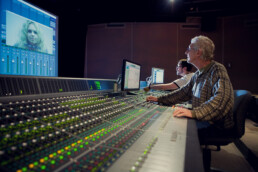
3. VERSIONING
In the next part of the finishing process, versioning is particularly important if your project is bound for delivery to another country. It might mean changing the voiceover, creating subtitles or altering motion graphics in another language. However, this would often be discussed in pre-production to make the versioning process as cost-effective as possible.

4. DELIVERY
There are as many different places to showcase your video in today’s technology-driven age as there are ways to make it. And that’s a lot. Social media, shopping centres, digital signage at sporting events, TV – get the drift? But it’s important to note that each of these mediums has specific requirements on how your video is delivered to ensure quality viewing.
The main elements to consider are the aspect ratio, meaning the size and shape of your screen, as some formats may require square video or Ultra HD, some may be short in height or on the other end of the scale – cinema screens. Again, this is something that would be discussed in pre-production so that the footage will work in whichever way it is executed.
At the finishing stage – but often discussed at pre-production – the editors could also be asked to provide a cut version of the video to suit other mediums.
5. FORMAT
Another factor to consider during the delivery stage is the format your video could be required in to suit other mediums. This will involve technical aspects such as pixel dimensions, codec (file type) and file size. As an example, for cinema, video files need to be in a super-high-quality format or Adobe to enable projection on the screen.
6. APPROVALS
There are also processes to go through for your content to be given publishing approval. Television commercials, in particular, need to go through an approval process (similar to a rating process), called ClearAds, to be given a classification, which determines what sort of programming they can be shown in. This is particularly important if the subject matter is sensitive. In these instances, pre-approval can be sought at the script stage of video production to ensure the content is valid and verifiable.
CONCLUSION
In a nutshell, the ‘finishing and delivery’ stage of video production is about polishing your video before showcasing it to the world. Look at it like being ready to apply hairspray over your up-do but still having an opportunity to add some more curls or change the style if you want. In this instance, hairspray is sound design, sound mixing, colour grading, and other technical aspects such as file type and size. These are all critical steps to takes your video to the next level as it gets closer to publishing. Speaking of which, you’re almost there – next up, we’re talking all about the distribution of your masterpiece.
Here at redbikini, we live and breathe all things video production, offering more than 20 years’ on-set experience. We are experts and passionate about what we do, from quick social, to web or online videos, training videos, animated videos, corporate videos, promotional videos, sales videos, product launch videos, event videos, and TV commercials to long-form television programs and documentaries.
You name it; we do it. A one-stop-shop, redbikini’s full-service offering as a video agency includes pre-production, logistics, location scouting, casting, scheduling and more, and we’re only a quick phone call, or email, away from providing our expert advice and guidance.

Follow our blog to stay up to date with the latest from redbikini.
GET IN TOUCH
5. Editing and Animation | 7 Essential Steps to Successful Video Production
In previous posts of our seven-part blog series, which details the essential steps to help ace your video content marketing, we have so far covered strategy, scripting, pre-production, production and finishing & delivery.
Now with step 5, we examine editing and animation.
By this stage, you should have all your raw footage – or rushes as they’re known among film buffs – and it is now time to piece it all together into a semi-finished product. This is where all the pieces of a puzzle come together, and you’re starting to see the bigger picture – the excitement is building! But before you start, there are still some crucial steps to take to ensure your video is picture-perfect.

1. REDEFINE YOUR PURPOSE
Now is an excellent time to go back over your strategy and remind yourself of the project’s purpose so that this logic is at the forefront of all decisions being made. It’s important to remember and define who your target audience is and what environment the video will be viewed, as this will influence the editing style to fit the audience you are attempting to engage with. When you have a clear purpose in mind, it’s easier to produce content and know what you want to be included or cut.
At this stage of video production, you’ll be selecting how you want the shots featured, and there is a range of editing styles to choose from. For example, the footages can be edited to be long and immersive or super-fast, i.e., less than one shot per second – it all depends on whom you are targeting and what message you’re trying to convey.
2. TIMING IS EVERYTHING
While some people are happy to sit around and watch hours of TV or movies in one sitting, the same can’t necessarily be said when viewing videos that market a business, brand, company or product. Essentially, you’ve got a small window to engage and captivate your audience and the adage ‘less is more is a good one to keep in mind. When editing your raw footage, it is essential to consider the video’s overall duration and remember that timing is everything. A general rule of thumb – if you think it seems too long, it probably is – brevity is critical.
While you know the strength of your brand, it is essential to understand that there is a vast amount of competing content online in today’s technology-driven era, and it’s all vying to engage with your audience. Your audience is surrounded by hundreds, even thousands, of competing videos attempting to entice them, so if your content isn’t immediately engaging, they’ll simply move on, and you’ll have lost an opportunity.

3. THE ART OF EDITING
While mobile phones and other devices have come a long way in recent years and enabled users to become somewhat amateur filmmakers, the art of editing is serious business and one the experts have studied long and hard to master.
Editing takes place on a computer editing station, which is super-fast, has a massive amount of fast memory, and costs a pretty penny. In a nutshell, the faster the computer, the faster the memory, the quicker the editing. There are as many editing styles and techniques as there are filming techniques and hundreds and thousands of ways of cutting material.
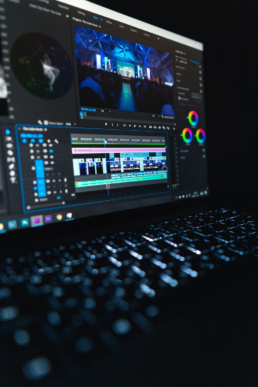
The process begins by inputting all the raw footage into editing software, followed by creating a content pass. This essentially is a rough draft, or rough editing, where your video will have a beginning, middle and an end and tells the story. This is usually the first time a client will see some of what’s been shot. If there are interviewees, they’ll all be featured, and if there is a voiceover, then that audio is laid down along with any relevant picture content.
At this point of the video creating process, many decisions are needing to make to identify what fits best, what works, and what doesn’t. It is a process of going back and forth and finessing. The first content pass is longer than the final cut, but this is an opportunity to understand what you can expect to see as a finished product. This will be a version of the video that doesn’t necessarily look pretty but gives you a basis and lays the groundwork.
Next comes the process of creating a visual pass, which takes all the overlay material, and in some instances, graphics and animation to bring the video to life. The two main options with animation are 2D and 3D, with 2D being far more straightforward as it is working within the flat framework of two-dimensional space. 3D animation, on the other hand, is far more complex because it is bringing in a third dimension, and visuals take on shape. If you are looking for something photo-real, i.e., realistic looking, the level of complexity goes up a notch again. Lighting, textures, and other environmental factors come into play to achieve a realistic result. While the process is incredibly time-consuming, when done well, it is extremely effective and engaging.
During the editing process, the process with both 2D and 3D starts with a design phase, including a non-animated version of the animation, to allow the client to see what the finished product will look like before it is completed. Once the design is finished, a wire-frame version is done to showcase how all the elements will move. You are now closer to a finished product.
4. Motion Ready
The last part of the editing process is adding motion graphics, which is often 2D animation incorporated with live-action footage that has been filmed. Motion graphics enhance what the viewer sees and drive the message home by highlighting certain aspects in a frame. They are also highly effective when hearing audio is compromised, such as at a busy shopping centre, an expo or tradeshow. Graphics can contain central messages and are a great tool because people can still understand the video’s essence even when they can’t hear what’s being said. They are attention-grabbing and can bring a dull corporate vision to life in an entertaining way.
5. Conclusion
Editing is a fascinating stage of video production because it means the finished product is within reach; there’s light at the end of the tunnel. It’s a stage that allows creative juices to flow, but it’s important to remember that post-production editing requires creativity and technical knowledge. Having great footage is just one aspect of the process; piecing it all together to tell a story effectively and engaging an audience is another.

Follow our blog to stay up to date with the latest from redbikini.
GET IN TOUCH
4. Production | 7 Essential Steps to Successful Video Production
So here we are, it’s Production Day
You’ve followed the steps to get here (click here to read our previous blogs on how to attain video production success) to help make the process as smooth as possible; there’s a strategy for the video concept, a script has been written and the all-important pre-production preparation is done. You’re ready to go and finally see your vision come to life.
This is an exciting stage, but it can also involve long days with potential hiccups along the way, so it is imperative to dot the i’s and cross the t’s to ensure smooth execution for the video production process.

THE STAR OF THE SHOW
As the client you’re the star of the show and it’s important you are presenting yourself in the best way possible. This is your big chance to showcase what you or your business is all about.
- Are you and your staff wearing your uniforms correctly?
- Is your branding on display?
- Have you got the props you want?
- If you’re shooting at your workplace, is everything in order?
Production days can be full on and exhausting, as well as expensive. Time is money and it is important to maximise any opportunities you have to showcase yourself in the best light on the day, it’s not as simple as trying again tomorrow or next week as this might be your one opportunity. Get it right the first time.
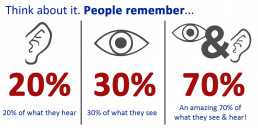
TAKE THE HORSE BY THE REIGNS
Maximise any opportunities that come your way and keep an eye out for any unexpected opportunities to create good visuals. Sometimes you just don’t know what you’ll be presented with until the day of shooting, regardless of how organised you are. Having a flexible creative approach to the day will work in your favour. Maybe the weather has suddenly turned, or your talent is having an off day – you just have to work around this. Think how you can turn a negative into a positive.
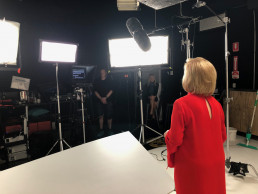
TIME IS OF THE ESSENCE
Two key points – stick to a schedule and view lists as your best friend.
Have a list of all the shots you want/need to get. That way, if any unexpected problems arise you know where you’re at and what still needs to be done. It will help keep you on track. If time starts getting away, you could miss out on important shots, but if you keep to a schedule as best as you can, it will help ensure a smooth run on the day.
Another good tip – keep moving. If problems arise, find a solution. Your talent might show up late, or not at all, but this doesn’t mean you should just sit around doing nothing. There’s always work to be done. Refer to your list to keep you in check but be flexible and keep moving so you can get the rest of the shots you need or new ones that spring to mind.
COMMUNICATION IS KEY
Effective communication can make the world of difference whether a project involves a bunch of people or just two. It is important to have open communication with the crew, on-camera talent, and anyone else involved in the project so that everyone has an understanding of what you are aiming for, what they need to do, and what to expect. Don’t catch people by surprise by keeping quiet, and don’t sit back if you’re not happy with how things are going.
- This is the time to speak up, not when everyone’s packed up and left.

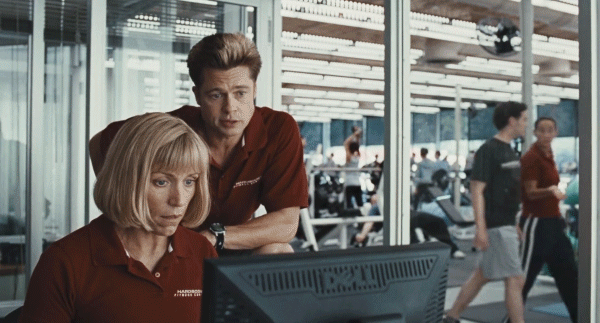
WATCH THE MONITOR
While it’s easy to watch what is happening before you with your ‘own eyes’, it’s important to note that’s not what is actually being captured by the camera during filming. Watching the monitor will give you the best indication of the footage you’ll see, because that’s exactly what is being captured. And given this might be your only chance to get footage, you need to be happy with what’s being shot because it’s not something you can easily change six months down the track. Remember, eyes on the monitor.
PAPER TRAILS
There is plenty involved with video production, but one of the most important things to do is ensure the paperwork is getting done. Quite often you’re working with unpaid talent and locations that don’t belong to you so it is imperative to have all the relevant release forms and documents signed, including any required permits to avoid any issues with filming. For example, you need permission to film at someone’s private residence, and even some public locations. You want to be prepared just in case someone shows up on set questioning why you are there or what you’re doing. You can put them – and yourself – at ease by ensuring all the relevant paperwork required is on set and can be pulled out to show those asking questions.
LOOK AFTER YOUR PEOPLE, AND YOURSELF
Filming days are generally long days. It’s not uncommon to do 10-to-12-hour shoots with early starts and late finishes, especially when you’re wanting to film at sunrise or sunset during the summer months. Ensure you provide a good supply of water, food and coffee to keep energy levels up. Look after the crew – and yourself – otherwise they start to fade and mistakes are made at your expense. Feed, caffeinate and hydrate.
And there you have it, our ‘must-knows’ that’ll have you well-equipped for a successful production day – go forth and shoot!
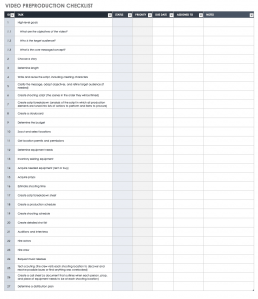
In summary, production day is an opportunity to showcase yourself or your business in the best possible light. To make the most of the opportunity, being presentable, using initiative and your time wisely, being organised but flexible, communicating effectively, dotting your i’s and crossing your t’s, and coffee (lots of coffee), will work in your favour.
Here at redbikini we live and breathe all things video production, offering more than 20 years’ on-set experience. We are experts and passionate about what we do. From quick social, to web or online videos, training videos, animated videos, corporate videos, promotional videos, sales videos, product launch videos, event videos, and TV commercials to long form television programs and documentaries. You name it, we do it. A one-stop-shop, redbikini’s full service offering as a video agency includes pre-production, logistics, location scouting, casting, scheduling and more, and we’re only a quick phone call, or email, away from providing our expert advice and guidance.
We explore this aspect more in the next blog post of this 7-part series, as we enter into chapter five of video production: Editing and Animation
Follow our blog to stay up to date with the latest from redbikini.
GET IN TOUCH
3. Pre-Production | 7 Essential Steps to Successful Video Production
Roll up, roll up, rolling! Before the exciting step of ‘Lights, camera, and action’ of video production, there’s people, places and things.
In previous posts of this blog series, we discussed the strategy and scripting stages of video production, (click here to read our previous blogs on how to attain video production success) and while it’s almost time to grab the camera and start rolling, there are still things that must be organised before the director can yell ‘action!’
In this blog we break down the importance of pre-production; the people and the roles required to make the filming process a success. After all, the show won’t go on without planning and practice – as well as a strong marketing strategy to pique audience interest. Naturally, there will be unexpected moments so being adaptable will work in your favour, but to ensure the smoothest run of events possible, organisation is key. Here’s what you need to consider:

PEOPLE
There’s more to the video production ‘circus’ than just a trapeze artist being the wow-factor. It’s the behind-the-scenes action you don’t necessarily see, which helps make the show spectacular.
Who is involved, and what do they do?
Director: The ringleader of the show, the director makes the creative decisions and decides what the audience sees. Well-versed in the technical and visual aspects of making video, the director has to consider budget, strategy and scripting, and works closely with the client, and crew, which includes producers, camera operators and talent.


Producer: A managerial role, the video producer is a true juggler. Working closely with the director and crew, they are in charge of devising and maintaining the budget, writing the script, hiring staff, organising talent, booking the filming venues, and editing.
Camera crew: The camera crew bring the director’s vision to life. They are responsible for capturing the raw material ready for the editors and animators to turn it into the sky-diving act. In pre-production, the types of cameras required to achieve the desired shots must also be organised, so that they capture everything the script stipulates, be it the talent, product or scenery.
Editor/Animator: The lion-tamers of the show, editors and animators wrangle the raw footage into picture lock. Following the video script and any changes that may have occurred during filming, an editor’s job is to piece together the footage. Both the editor and animator need to be organised in the pre-production phase and briefed on the desired result, so they can work out the best way to achieve it. More complex animation, such as 3D architectural renders and cinematographic scenes, will require a lead animator and a supporting team, as well as additional storyboarding to achieve the desired design elements and style, which can range from flat cut-out characters to hyper-realism. The script is very important here, as voiceovers determine the timing for the animation of spoken words provided by the talent.
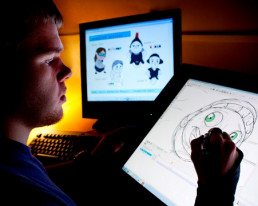
Cast/Talent: The cast and talent are the fire-breathers and trapeze artists of the production, bringing the script to life. The talent will vary depending on the type of video being made; for example, consisting of client staff and customers, members of the public, or professional actors. Video production companies such as redbikini can put out casting calls to scope talent from acting agencies and casting directors. With the director, producer and often the client present, a casting session can be arranged with a script reading to select the best cast for the video.
Essential liaisons + extras hands: Not every video will require a full crew, but those featuring live-animation and large or intricate sets, for example, will often require an art department to achieve the desired aesthetic vision. For music videos and voiceovers, sound production will likely be required for the best audio quality. Writers can assist or be in charge of the script, makeup artists and costume designers may be necessary for more theatrical productions, and production assistants are that extra pair of hands that help make lighter work, operating auto-cue or simply keeping everyone caffeinated to keep the day moving smoothly.
PLACES
There’s no circus without a striped tent, which of course means sourcing a location. The same goes for filming, and locations must be agreed upon and booked pre-production. This process can include:
Site visits: Scoping the location for any test shots required. In this process, if there is anything inhibiting filming ideas, it allows time to edit the script, find an alternative shot solution if necessary, or search for a different location.
Booking and permissions: Securing the location is crucial, as is getting permission to film there. Should you be using drone cameras, not only does your drone operator need to be qualified, you may also need clearance to film in the area.

THINGS
From flame throwers to costumes, camera gear and thematic props, ‘things’ are that which will be present in the video production– and again, these must be organised in pre-production. Think cameras and their corresponding accessories, lighting, green screen, wardrobe and makeup, hand-held props, auto-cue. Even catering gets a mention – it’s a big working day, and it is imperative to plan ahead so you’re not caught short.
Pre-production is the background hard yards that tie the strategy and script to production. Check out our favourite examples of what can be achieved through clever and thorough pre-production in our latest reel – featuring sky-high locations, animation, broadcast-style shoots, and more:

HERE From the Director to cast and everyone in between, redbikini’s talented team offers everything you need to create a professional, polished video. Whether you need a video production company to help you script, produce, direct, budget, cast, film, edit, or animate your video, redbikini can deliver a detailed strategy to lead you to success. Meet our Team here.
Check out the other posts in this blog series providing you with all the tools for successful video production. In our next blog about Production, we’re rolling — chookas!
Follow our blog to stay up to date with the latest from redbikini.
GET IN TOUCH
Sujan
Sujan Bhusal
Digital Marketing Specialist
Sujan builds cross platform digital marketing strategies, like a spider does a web: trapping his prey with the greatest of skill. Armed with a double Bachelors degree and strong analytical skills, Sujan’s greatest passion is to incite a positive growth in numbers. Thankfully he can break down graphs into palatable information, much to the relief of the left-brained creatives around him. a




